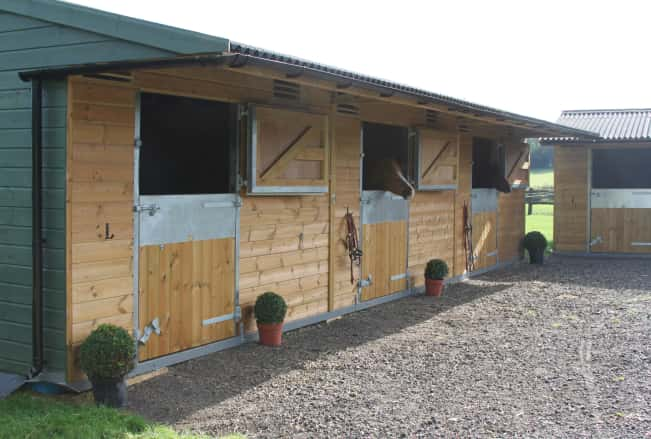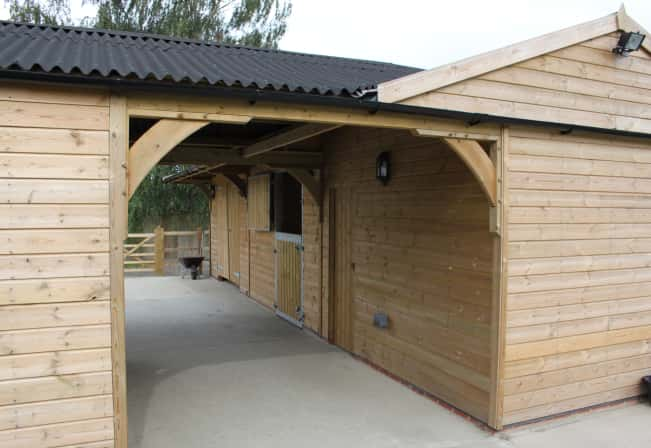Are stables classed as agricultural buildings?
Owning agricultural land means that, under the Planning Acts, you can use your land for dairy farming, to cultivate soil, grow crops, raise livestock, and use the land for grazing. The type of buildings that fall under the umbrella of ‘agricultural’ can sometimes be confusing, particularly to horse owners. In simple terms, an agricultural building tends to refer to a building (other than the house in which you live) which is used together with agricultural land and is used solely in relation to agricultural purposes on that land. An agricultural structure would typically be used to house hay, grain, poultry, livestock, farm machinery, and other agricultural related products.
So, do horse stables fall under the term ‘agricultural building, I hear you ask? Well, it depends on your purpose for keeping a horse. To provide clarity, let us first look at what is meant by ‘keeping horses’…
Keeping horses is a general term that covers a host of ways in which you can own or care for horses. Owning more than one horse for private or leisure purposes falls under the ‘keeping horses’ umbrella. Similarly, so do riding schools and livery yards, as well as racing stables and stud farms. However, if you want to keep horses on agricultural land as livestock to serve no other purpose than to graze the land, then a temporary shelter may fall within the legal definition of “agricultural building.”

The reality is that this is very rarely the case. Essentially, if you own horses for any of the most common reasons, such as for recreational riding or sport, then you are ‘keeping horses’ and, therefore, planning permission for agricultural land will apply to you as a horse owner. This means consent for a permanent stable will need to be given.
It is super important to familiarise yourself with the planning legislation on keeping horses on agricultural land, known as the Town and Country Planning Act 1990 (TCPA). Failure to comply may result in enforcement action with some pretty serious consequences attached.
To determine whether the horses on the land are solely grazing, rather than being kept for recreational purposes, a local authority will look at a number of considerations before deciding whether the land is being used for agricultural or equestrian purposes. These include:
- What the horses are eating. If they are being supplementary fed to the extent that grazing is secondary, the use of the land is unlikely to be considered agricultural.
- How the horses are using the field. If the horses are being exercised on the land, the land use will not be considered agricultural.
- Are there any other animals in the field? Is it used purely for horse or do other animals graze in it?
- Equipment on the land. Are there any structures relating to the training or exercising of horses? If so, this would clearly point to the horses being kept there for leisure purposes rather than agricultural.
Do I need planning permission to build a horse stable on agricultural land?
Planning permission for any building can be complicated, so always seek the advice of your local planning authority, no matter how certain you are that you may or may not need consent. You will need to obtain planning permission when changing agricultural land into land that is to be used for keeping horses. As horses are typically not considered agricultural animals, changing how you use your land to accommodate them is considered a ‘change of use.’ A change of use requirement means that if you want to build a stable on the land you must seek full planning permission before you do so. Do not assume that by owning the land you can do what you want with it. If you are changing how the agricultural land is going to be used you must seek planning consent, especially if your stable or buildings are likely to be used to run a business.
Change of use permissions also apply to any existing barns or outbuildings on your agricultural land that you want to convert into stables. Because the purpose of the building is changing from agricultural use to keeping horses, you will need permission to make the change.
When is planning permission on agricultural land not required for stables?
To shelter horses on agricultural land without going through the planning permission process, you will need to build a temporary structure, such as a mobile field shelter. Field shelters are possible to erect without planning consent, providing they qualify as temporary structures and the land is classified to allow equine use (i.e. you have first requested a change of use to use the land for equestrian purposes). To qualify as a temporary structure the shelter must:
- Be moveable and relocated to a different position every 28 days
- Be less than 100m2
- Not exceed 25% of your land.
- Not be located within 5m of your boundary.

In summary, unlike farms, land for equestrian facilities does not have any agricultural permitted development rights. This means that if you are keeping horses for any reason other than grazing (agricultural) purposes, such as recreation, sport, or business, then most developments will require planning consent.
Remember, you will also need to request a change of use permission if you want to use existing agricultural land for any purpose other than an agricultural one. This includes converting existing outbuildings into stables, building new structures on the land, and converting the daily use of the land from private to commercial purposes. In short, you will need change of use permissions for stables if you want to:
- Convert residential outdoor space to equestrian space
- Change agricultural land to an equestrian space for keeping horses
- Convert private use land to land for commercial purposes
- Change a livery yard into a riding school or other commercial property
When permissions are granted and the time comes to think about the design and build of your new stable or mobile field shelter, we’d love to offer our 40 years’ experience within the bespoke timber buildings and wooden horse stables niche to you. We specialise in timber structures in Hampshire and the surrounding areas. We’re always at the end of the line if you want to chat through your requirements. We can offer expert planning advice too if you’re still unsure of what is expected.
Your free brochure
We make sure every prospective client has a copy of our brochure – this gives you the chance to browse examples of our products and see the quality of our workmanship. Plus, you will find details of our pricing so you can begin planning your project properly. From a stable block to a mobile stable, you will find an option to suit you perfectly.
Our brochure is 100% free of charge and is the perfect way to get your project off the ground.
Enter your postcode to request your brochure.




